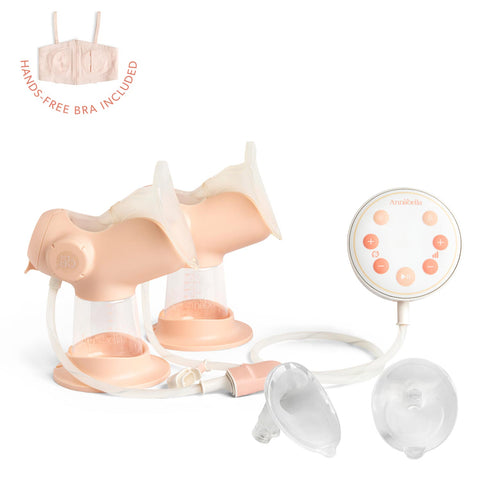Induced lactation is the process of stimulating the body to produce breast milk without pregnancy. It allows non-gestational parents, including adoptive parents, surrogates, transgender women, and non-birthing partners, to breastfeed their child. A breast pump plays a critical role in this process, helping to mimic the natural suckling stimulus that triggers milk production.
Using a breast pump to induce lactation can offer a profound way to bond with the baby. It supports the emotional benefits of breastfeeding and offers the baby the protective and developmental properties of breast milk. With dedication, the right equipment, and support, many parents successfully establish milk supply through pumping alone.
Why Use a Breast Pump to Induce Lactation?
Induced lactation allows parents who did not give birth to experience breastfeeding. It strengthens bonding and provides babies with valuable immune protection.
A breast pump to induce lactation is essential because it replicates an infant’s feeding patterns. Regular pumping triggers the hormonal responses needed to start and maintain milk production. The mechanical stimulation of a breast pump supports galactopoiesis, the body’s process of making milk, especially when used on a consistent schedule.
Frequent pumping builds and maintains supply over time. Mechanical pumping helps start lactation even before the baby arrives. For many, it's essential to making breastfeeding possible.
How to Use a Breast Pump to Induce Lactation
Plan and Prepare: Most parents follow the Newman-Goldfarb protocol. It often includes birth control pills and galactagogues like domperidone to simulate pregnancy and stimulate prolactin levels. Always consult a healthcare provider before beginning any medical regimen. Choose a hospital-grade breast pump to induce lactation. Create a schedule and stick to it for the best results. Consistency, patience, and planning lay the foundation for successful lactation. Start early and stay committed throughout the journey.
Pumping Schedule & Techniques: Use a hospital-grade or double electric pump 8 to 10 times per day. This mimics a newborn’s feeding frequency. Employ two-phase pumping and double pumping techniques to increase output. Studies suggest that hands-on pumping, massaging the breast while pumping, may significantly improve milk volume.
Supporting Your Journey
Inducing lactation is a process that takes time, patience, and support. You don’t have to do it alone. The right guidance can make all the difference.
What to Expect in the First Weeks
In the early days, milk production may be minimal or absent. This is normal. The body needs time to respond to stimulation. You may see only drops at first. Don’t be discouraged. Over time, and with consistent pumping, supply usually increases. Breast changes, such as fullness or tingling, may signal progress. Record your sessions, stay hydrated, and rest as much as possible. Partner support during this stage is especially valuable.
Hormonal and Medication Support
Removing hormonal inhibitors can help trigger lactation. Medications like domperidone may increase prolactin levels, supporting milk production. These medications should only be used under medical supervision. Your doctor can advise you on safety and effectiveness. A personalized care plan ensures that medications and hormones are used properly for your unique health needs.
Tracking & Adjustments
Track pumped volume, baby’s weight, latch, and pump sessions. Monitor these regularly to make informed adjustments. Check flange size and suction levels to prevent pain or injury. A comfortable fit supports better milk flow – Annabella’s breast shield size is adjustable. Adjust your approach as needed. Consult a lactation expert if your results plateau or discomfort persists.
Emotional and Practical Support
Inducing lactation takes time, patience, and emotional strength. Work with a lactation consultant, find peer support groups, and prioritize mental health. Know that supply may not always match full feeding needs and that’s okay. You are not alone. Many families need encouragement to reach their lactation goals.
What to Expect: Rewards and Challenges
Like any parenting path, induced lactation comes with highs and lows. Understanding the potential benefits and hurdles can prepare you emotionally and practically. Let’s look at both.
Benefits
Using a breast pump to induce lactation can strengthen emotional bonds and parenting roles. It creates deep connections through feeding. Breast milk contains protective antibodies. It supports your baby’s development in unique and powerful ways. Even partial milk supply gives babies the benefits of breastfeeding. Every drop matters.
Challenges
Induced lactation requires time, consistency, patience and proper equipment. Emotional highs and lows are part of the journey. Some parents may not achieve a full milk supply. Supplementation may still be needed. This journey requires flexibility. Focus on bonding and shared care over perfection.
Real-Life Experiences
Many adoptive parents, same-sex couples, and transgender mothers have successfully used a breast pump to induce lactation. Each experience is unique. Some parents achieved a full milk supply. Others produced smaller amounts, supplementing with donor milk or formula
Their journeys show, while not always easy, it is entirely possible and incredibly rewarding with the right tools and support. Their stories are powerful examples of love and determination.
One adoptive mother shared that even producing a few ounces gave her a sense of connection and purpose. A transgender parent described the joy of being able to nurse using a combination of pumping and an SNS. These journeys show that with support, commitment, and the right tools, breastfeeding through induced lactation is possible and deeply fulfilling.
You’ve Got This: Making Induced Lactation Your Own
Using a breast pump to induce lactation is a powerful option for non-gestational parents. It creates connection and nourishes your baby. With time, dedication, and professional support, you can experience the deep connection and benefits of breastfeeding.
Consult a lactation professional to create a personalized plan that supports both you and your baby.







